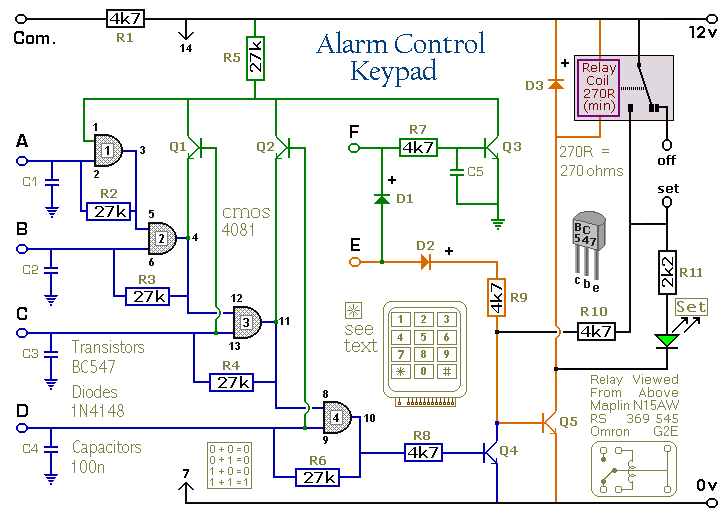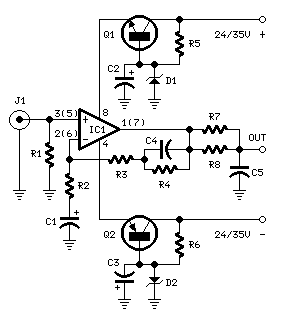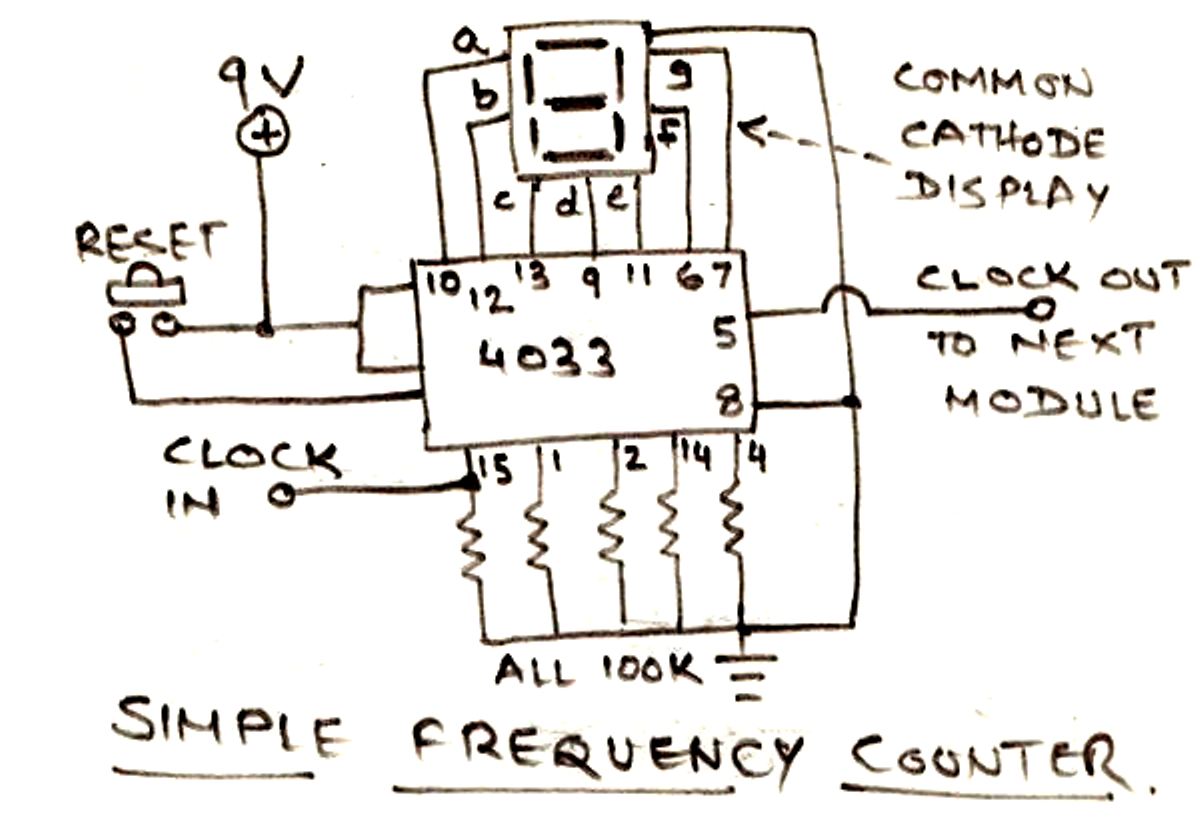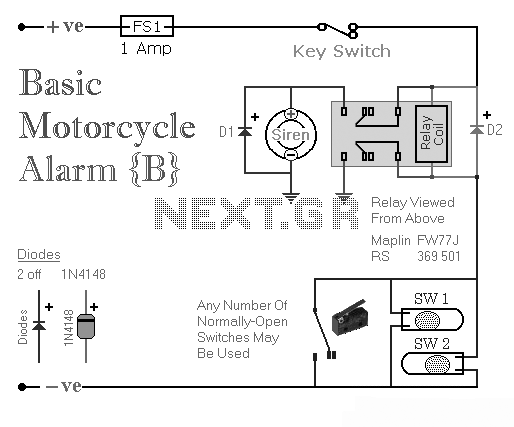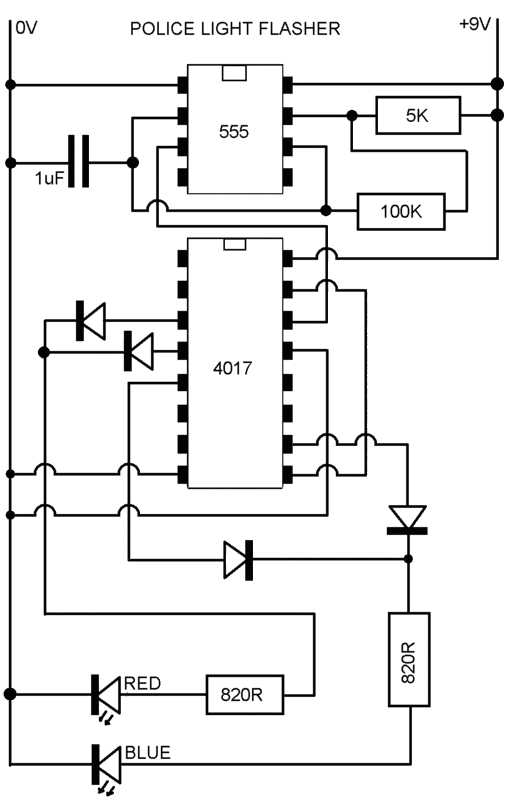
Simple Cat.5 Network Tester

This circuit was developed to fulfill the requirement for a simple network tester that can be operated by a single individual. Previous commercial units necessitated the presence of a person at the other end to observe the remote LEDs, as the transmitters were incapable of cycling through the tests continuously for a solo user to verify both ends. It is important to note that this unit is designed solely for checking pair continuity, pair shorts, crossed wires, and shorts to other pairs. It does not assess bandwidth or similar parameters. The operation of the circuit is relatively straightforward. One half of the 4011 quad 2-input NAND gate functions as an RS flip-flop (IC1a, IC1b), which controls the other half (IC1c & IC1d) that operates as a clock oscillator. The oscillator can be initiated and halted using the Start and Stop switches, or alternatively, the Stop switch can be utilized to allow manual clocking of the 4017 counter via diode D1 connected to pins 12 and 13. The 4017 drives one of eight LEDs and the connections to the RJ45 socket. An output "High" on the 4017 determines which line is being tested; if the circuit is complete, the current for the test LED is "sunk" by the 4017, causing the LED to illuminate. If the corresponding test LED on the remote side does not light up, it indicates a short in that pair of the cable being tested. If multiple LEDs illuminate, it signifies a short with another pair. A non-illuminated test LED on the transmitter indicates that the pair is an open circuit. The "Start" button initiates the circuit cycling at a frequency determined by the 470nF capacitor and 220kΩ resistor, while the "Stop/Step" button halts the cycling, allowing the user to step through the lines. When stepped to a position where no channel LEDs are lit, the unit effectively turns off, maintaining a standby current drain of less than one microamp.
The network tester circuit utilizes a compact design that leverages the 4011 quad NAND gate IC, which provides both flip-flop functionality and clock generation capabilities. The RS flip-flop configuration allows for stable operation of the oscillator, which is critical for cycling through the test sequences. The clock oscillator's frequency can be adjusted by varying the capacitor and resistor values, enabling customization based on user requirements.
The 4017 decade counter is pivotal in this circuit, as it sequentially activates the corresponding LEDs and tests the network lines. Each output pin of the 4017 connects to a specific test line in the RJ45 connector, allowing for systematic testing of each pair. The logic of the circuit ensures that when an output is high, the corresponding LED lights up, providing immediate visual feedback on the status of the cable under test.
In terms of diagnostics, the circuit's design enables quick identification of faults within the network cable. The illumination of multiple LEDs indicates shorts between pairs, while the absence of light in the test LED signifies an open circuit. This functionality is essential for troubleshooting network issues effectively.
The power management aspect of the circuit is noteworthy, as it is designed to operate with minimal power consumption when idle. The standby current of less than one microamp is particularly advantageous for battery-operated or portable applications, ensuring extended operational life without frequent battery replacements.
Overall, this network tester circuit is a practical solution for network diagnostics, allowing a single user to efficiently check cable integrity without the need for additional personnel. Its straightforward operation, combined with effective visual indicators and low power consumption, makes it a valuable tool for electronics engineers and network technicians alike.This circuit came from a need for a "quick and dirty" network tester that could be operated by one person. All the commercial units I tried required a person at the other end to check the remote LEDs, as the transmitters could not be made to cycle through the test continuously to allow one person to check both ends.
It must be noted that this unit will only check for pair continuity, pair shorts, crossed wires, and shorts to other pairs. It will not test bandwidth, etc. Operation is fairly basic. Half of the 4011 quad 2-input NAND gate is an RS flip-flop (IC1a, IC1b) which controls the other half, IC1c & IC1d, operating as a clock oscillator. You can either start and stop the oscillator running by pressing the Start and Stop switches or by virtue of diode D1 connected to pins 12 & 13, use the Stop switch to allow manual clocking of the 4017 counter.
The 4017 drives one of eight LEDs and the lines to the RJ45 socket. An output "High" on the 4017 decides which line is under test, and if the circuit is complete, the test LED`s current is "sunk" by the 4017 and the LED will light. If the corresponding test LED on the remote fails to light, then there is a short of that pair in the cable under test.
If more than one LED lights, it indicates a short with another pair. A dark test LED on the transmitter indicates that pair is open circuit. "Start" starts the circuit cycling at a rate determined by the 470nF capacitor and 220kO resistor and "Stop/Step" stops cycling, steps through the lines, and when stepped so that no channel LEDs are alight, effectively switches the unit off with a standby drain current of less than a microamp. 🔗 External reference
The network tester circuit utilizes a compact design that leverages the 4011 quad NAND gate IC, which provides both flip-flop functionality and clock generation capabilities. The RS flip-flop configuration allows for stable operation of the oscillator, which is critical for cycling through the test sequences. The clock oscillator's frequency can be adjusted by varying the capacitor and resistor values, enabling customization based on user requirements.
The 4017 decade counter is pivotal in this circuit, as it sequentially activates the corresponding LEDs and tests the network lines. Each output pin of the 4017 connects to a specific test line in the RJ45 connector, allowing for systematic testing of each pair. The logic of the circuit ensures that when an output is high, the corresponding LED lights up, providing immediate visual feedback on the status of the cable under test.
In terms of diagnostics, the circuit's design enables quick identification of faults within the network cable. The illumination of multiple LEDs indicates shorts between pairs, while the absence of light in the test LED signifies an open circuit. This functionality is essential for troubleshooting network issues effectively.
The power management aspect of the circuit is noteworthy, as it is designed to operate with minimal power consumption when idle. The standby current of less than one microamp is particularly advantageous for battery-operated or portable applications, ensuring extended operational life without frequent battery replacements.
Overall, this network tester circuit is a practical solution for network diagnostics, allowing a single user to efficiently check cable integrity without the need for additional personnel. Its straightforward operation, combined with effective visual indicators and low power consumption, makes it a valuable tool for electronics engineers and network technicians alike.This circuit came from a need for a "quick and dirty" network tester that could be operated by one person. All the commercial units I tried required a person at the other end to check the remote LEDs, as the transmitters could not be made to cycle through the test continuously to allow one person to check both ends.
It must be noted that this unit will only check for pair continuity, pair shorts, crossed wires, and shorts to other pairs. It will not test bandwidth, etc. Operation is fairly basic. Half of the 4011 quad 2-input NAND gate is an RS flip-flop (IC1a, IC1b) which controls the other half, IC1c & IC1d, operating as a clock oscillator. You can either start and stop the oscillator running by pressing the Start and Stop switches or by virtue of diode D1 connected to pins 12 & 13, use the Stop switch to allow manual clocking of the 4017 counter.
The 4017 drives one of eight LEDs and the lines to the RJ45 socket. An output "High" on the 4017 decides which line is under test, and if the circuit is complete, the test LED`s current is "sunk" by the 4017 and the LED will light. If the corresponding test LED on the remote fails to light, then there is a short of that pair in the cable under test.
If more than one LED lights, it indicates a short with another pair. A dark test LED on the transmitter indicates that pair is open circuit. "Start" starts the circuit cycling at a rate determined by the 470nF capacitor and 220kO resistor and "Stop/Step" stops cycling, steps through the lines, and when stepped so that no channel LEDs are alight, effectively switches the unit off with a standby drain current of less than a microamp. 🔗 External reference
